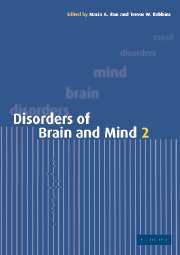Book contents
- Frontmatter
- Contents
- List of contributors
- Preface
- Part I Genes and behaviour
- Part II Brain development
- Part III New ways of imaging the brain
- Part VI Imaging the normal and abnormal mind
- Part V Consciousness and will
- Part IV Recent advances in dementia
- Part VII Affective illness
- Part VIII Aggression
- 17 Human aggression: biological correlates and environmental influences
- 18 A neurocognitive model of the psychopathic individual
- Part IX Drug use and abuse
- Index
- Plate section
- References
18 - A neurocognitive model of the psychopathic individual
from Part VIII - Aggression
Published online by Cambridge University Press: 19 January 2010
- Frontmatter
- Contents
- List of contributors
- Preface
- Part I Genes and behaviour
- Part II Brain development
- Part III New ways of imaging the brain
- Part VI Imaging the normal and abnormal mind
- Part V Consciousness and will
- Part IV Recent advances in dementia
- Part VII Affective illness
- Part VIII Aggression
- 17 Human aggression: biological correlates and environmental influences
- 18 A neurocognitive model of the psychopathic individual
- Part IX Drug use and abuse
- Index
- Plate section
- References
Summary
Introduction
The goal of this chapter is to consider a neurocognitive model of the psychopathic individual. Psychopathy is not synonymous with a diagnosis of either conduct disorder (CD) or antisocial personality disorder (APD) but rather is an extension of these DSM–IV diagnoses (American Psychiatric Association 1994). Psychopathy, in both children and adults, is currently defined by high scores on clinically based rating scales: for children, the Psychopathy Screening Device (PSD; Frick and Hare, in press) and for adults, the Revised Psychopathy Checklist (PCL–R; Hare 1991). Factor analyses of behaviours rated on both the PSD and PCL reveal two independent factors: (1) an emotion dysfunction factor defined largely by emotional shallowness and lack of guilt and (2) an antisocial behaviour factor defined largely by impulsive aggression and the commission of a wide variety of offence types (Harpur et al. 1989; Hare et al. 1991; Frick et al. 1994). High scores on Factor 2 of the PSD and PCL are closely associated with the diagnosis of CD and APD respectively (Frick et al. 1994). However, high scores on Factor 1, while highly correlated with scores on Factor 2, are less closely associated with the DSM diagnoses. More interestingly, scores on Factor 1 have different correlates from scores on Factor 2. Thus, both socio-economic status and IQ are correlated with Factor 2 scores, but neither is associated with scores on Factor 1 (Hare et al. 1991). Moreover, while Factor 2 score declines with age, Factor 1 score remains constant (Harpur and Hare 1994).
- Type
- Chapter
- Information
- Disorders of Brain and Mind , pp. 400 - 418Publisher: Cambridge University PressPrint publication year: 2003
References
- 7
- Cited by



